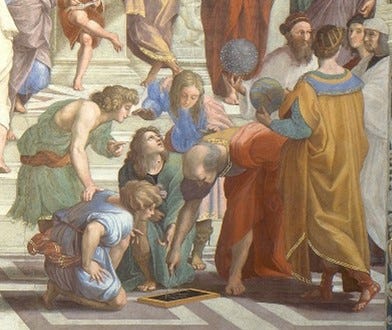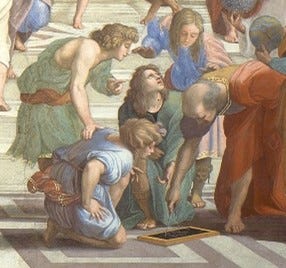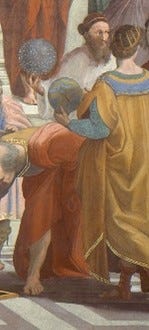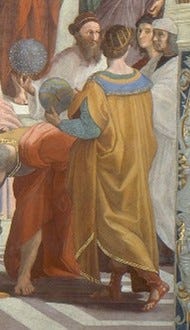THE DISCOVERY OF THE SCHOOL OF ATHENS
Part 10 - the School of Alexandria
Having now succeeded in going down the stairs, by following Theaetetus, Eudoxus and Euclid, we have arrived at the scene in the right foreground.
Now, while looking in the same direction that Euclid is facing, we see four young people standing or kneeling around an older person who is bent over and holding a compass down to a diagram on a slate board, as if he is demonstrating a geometrical problem to these four young people. This could be Archimedes, who lived from 290 to 212 BC.
The works of Archimedes which have survived are: ‘On the sphere and cylinder’, ‘Measurement of a circle’, ‘On conoids and spheroids’, ‘On spirals’, ‘On the equilibrium of planes’, ‘The sand-reckoner’, ‘Quadrature of the parabola’, ‘On floating Bodies’, ‘Book of lemmas’, ‘The cattle-problem’, and ‘The method of Archimedes’.
To learn about Archimedes, the following is from ‘The Life of Marcellus’ by Plutarch:
“Yet Archimedes possessed so high a spirit, so profound a soul, and such treasures of scientific knowledge, that though these inventions had now obtained him the renown of more than human sagacity, he yet would not deign to leave behind him any commentary or writing on such subjects; but, repudiating as sordid and ignoble the whole trade of engineering, and every sort of art that lends itself to mere use and profit, he placed his whole affection and ambition in those purer speculations where there can be no reference to the vulgar needs of life; studies, the superiority of which to all others is unquestioned, and in which the only doubt can be whether the beauty and grandeur of the subjects examined, of the precision and cogency of the methods and means of proof, most deserve our attention.
It is not possible to find in all geometry more difficult and intricate questions, or more simple and lucid explanations. Some ascribe this to his natural genius; while others think that incredible effort and toil produced these, to all appearances, easy and unlaboured results. No amount of investigation of yours will succeed in attaining the proof, and yet, once seen, you immediately believe you would have discovered it; by so smooth and so rapid a path he leads you to the conclusion required.
And thus it ceases to be incredible that (as is commonly told of him) the charm of his familiar and domestic Siren made him forget his food and neglect his person, to that degree that when he was occasionally carried by absolute violence to bathe or have his body anointed, he used to trace geometrical figures in the ashes of the fire, and diagrams in the oil on his body, being in a state of entire preoccupation, and, in the truest sense, divine possession with his love and delight in science.
His discoveries were numerous and admirable; but he is said to have requested his friends and relations that, when he was dead, they would place over his tomb a sphere containing a cylinder, inscribing it with the ratio which the containing solid bears to the contained.
Archimedes, however, in writing to King Hiero, whose friend and near relation he was, had stated that given the force, any given weight might be moved, and even boasted, we are told, relying on the strength of demonstration, that if there were another earth, by going into it he could remove this.”
And the following about Archimedes is from Pappus:
“Although many solid figures having all kinds of surfaces can be conceived, those which appear to be regularly formed are most deserving of attention. Those include not only the five figures found in the godlike Plato, but also the solids, thirteen in number, which were discovered by Archimedes and are contained by equilateral and equiangular, but not similar, polygons.”
This person, who is bent over and holding a compass to show a geometry lesson to his four students, should be Archimedes, the master geometer, who after studying the five Platonic solids, is credited with the discovery of the thirteen Archimedean solids.
And, if we look behind and to the right of Archimedes, we see someone with a beard, who is wearing a hat, and who is standing and holding in his hand a sphere with the stars marked on it, as if he is demonstrating an astronomical problem. This could be Aristarchus, who lived from 310 to 230 BC.
Very little is known about the life of Aristarchus. It is said that he was born on the island of Samos, the same island where Pythagoras was born, and that he studied at the school at Alexandria. The only surviving work of Aristarchus is ‘On the Sizes and Distances of the Sun and Moon’.
In ‘The Sand-Reckoner’, Archimedes refers to a book by Aristarchus, that has since been lost:
“Now you (King Gelon) are aware that ‘universe’ is the name given by most astronomers to the sphere whose centre is the centre of the earth and whose radius is equal to the straight line between the centre of the sun and the centre of the earth. This is the common account as you have heard from astronomers.
But Aristarchus of Samos brought out a book consisting of some hypotheses, in which the premises lead to the result that the universe is many times greater than that now so called. His hypotheses are that the fixed stars and the sun remain unmoved, that the earth revolves about the sun in the circumference of a circle, the sun lying in the middle of the orbit, and that the sphere of the fixed stars, situated about the same centre as the sun, is so great that the circle in which he supposes the earth to revolve bears such a proportion to the distance of the fixed stars as the centre of the sphere bears to its surface.”
And the following about Aristarchus is from ‘On the Face of the Disc of the Moon’, by Plutarch:
“Only do not, my good fellow, enter an action against me for impiety in the style of Cleanthes, who thought it was the duty of the Greeks to indict Aristarchus of Samos on the charge of impiety for putting in motion the Hearth of the Universe, this being the effect of his attempts to save the phenomena by supposing the heaven to remain at rest and the earth to revolve in an oblique circle, while it rotates, at the same time, about its own axis.”
It seems that Aristarchus had this idea that the earth rotates about its own axis, and that it revolves around the sun - an idea that was rejected by Aristotle and Ptolemy and others, until Copernicus about 1800 years later; and that the radius of the sphere of the fixed stars was many times greater than the radius of the orbit of the earth. And so, I think that this person holding a celestial globe, should be Aristarchus.
Now, if we look in front and to the right of Archimedes, we find someone standing, facing Aristarchus, with his back to us, and who, in his left hand, is holding a globe of the earth. This could be Eratosthenes, who lived from 276 to 194 BC.
“Eratosthenes, perhaps the greatest scientist of the Hellenistic world, was also one of its most prolific and versatile: His work included investigations in astronomy, geography, geodesy, poetry, music, drama, and philosophy. Born in Cyrene, he was educated in Alexandria, Egypt, and Athens by followers of Plato. At the age of 40, he became the head of the famous library at Alexandria, where he remained until his death. In addition to his measurement of the Earth's circumference, Eratosthenes was the first to measure the angle of the Earth's tilt on its axis (the plane of the ecliptic). He also wrote ‘The Duplication of the Cube’, and ‘On Means’, which were treatises investigating the crucial mathematical paradoxes arising from the investigation of dimensionality. His work ‘Platonicus’ deals with the mathematical and musical principles of Plato's philosophy. He published maps and works on geography and chronology. Eratosthenes was also a poet, dramatist, and philologist, writing several poems and plays, only fragments of which survive, and a book on comedy. Other ancient writers attribute to Eratosthenes books on philosophy and history.” [from ‘Eratosthenes’ by Bruce Director]
None of the works of Eratosthenes have survived. ‘Platonicus’, on Plato’s mathematics and also on the history of the problem of duplicating the cube, can be found in ‘Exposito rerum Mathematicarum’ by Theon of Smyrna. The ‘Seive of Eratosthenes’, his work on prime numbers, can be found in ‘Introduction to Arithmetic’ by Nicomedes. ‘On the measurement of the Earth’ can be found in ‘De Contemplatione Orbium Ceolestium’ by Cleomedes. ‘On Means’ is mentioned by Pappus as one of the great books of geometry.
And concerning ‘the celebrated measurement of the curvature of our planet by Eratosthenes’, Lyndon LaRouche wrote:
“In recent time, I have often employed this discovery by Eratosthenes. That choice reflects the fact that this discovery provides the simplest, cleanest example of the way in which Platonic ideas arise in every fundamental, experimental discovery of physical principle. By comparing the angles cast by the noonday shadow upon the interior of hemispherical sundials, along the meridian linking Syene (Aswan) to Alexandria, in Egypt, Eratosthenes demonstrated, geodetically, that the Earth was a spheroid, estimating the Earth's polar diameter with a margin of error of approximately fifty miles. The relevant paradox is, that Eratosthenes measured the curvature of the Earth’s meridian more than two thousand years before any person was to have seen our planet’s curvature. The principle of the Earth’s curvature, as adduced thus, represents a Platonic idea: a conception of measurable relationship, a relationship which is not directly perceived as a sense perception, nor as a new theorem of an existing deductive form of theorem-lattice. All such notions of measurable relationship which underlie the principles of astrophysics, are obtained only as ‘Platonic ideas’. [from ‘The Essential Role of Time Reversal in Mathematical Economics’, October 1996]
Let us look at how we moved from the scene at the top of the stairs – from the standing Theaetetus and Eudoxus to the sitting Euclid, to this scene at the bottom of the stairs – from a half-kneeling student, through the bent-over Archimedes, to the standing Aristarchus and Eratosthenes.
We should be reminded of the fate of the School of Athens: as the New Academy is falling into skepticism, some Greeks leave Athens and move to Alexandria in Egypt to revive the real Plato - such as Eratosthenes who became head of the library there.
Again in looking at this scene, and comparing it with the previous two scenes (the first – the Eleatic ‘Paradox’, and the second – Plato’s ‘Poetic Principle’) it appears that each of the three persons here at the bottom of the stairs – Archimedes, Aristarchus and Eratosthenes – lived after the time of Plato, and are seen being involved in showing or demonstrating something, as if trying to ‘prove’ something – to ‘prove’ a ‘Platonic idea’.
And, we have arrived at the final stop of what LaRouche calls our ‘three-step method of sharing such an experience – paradox, hypothesis and validation’ !
The following is from ‘The Coming Death of Systems Analysis’, March 2000, by Lyndon LaRouche:
“The discoveries of what are later experimentally validated as universal physical principles, are prompted by the demonstration of those qualities of paradoxes, the which are not susceptible of formal solution by means of the deductive and other methods of the philosophical reductionists. Such paradoxes are typified by the ontological paradox of Plato’s Parmenides dialogue; the impossibility of solving such by deductive methods, is typified by the case of that historical Parmenides, whose method Plato referenced in that dialogue.
A successful solution is generated when something occurs, the which is sometimes described as an ignited flash of insight, to produce a validatable hypothesis in that person's mind. The acceptance of that hypothesis by other persons within society, requires that two special conditions be satisfied. First, the same experience of insight must be replicated, independently, within the sovereign cognitive precincts of at least one other individual's mind. Second, that hypothesis, so generated, must be shown to be an existent, efficient principle, by means of experimental demonstration of the efficiency of its willful application to the physical domain as a whole. The latter such experiments belong to the class which Riemann defined as unique: it is not sufficient to show experimentally that the prescribed effect might be produced; it must also be demonstrated that that hypothetical universal principle coheres, in a multiply connected way, with all validated other universal physical principles.
The crucial point is, that the only way in which we can generate a functionally efficient notion of such a cognitive idea existing in another mind, is the three-step method of sharing such an experience (paradox, hypothesis, validation), as I have just identified this summarily. In such a case, we know three essential things.
First, we know, independently of our cognitive processes, the paradox which prompted the generation of a discovery of principle, as the only feasible solution to that paradox. Thirdly, we know the manifest experimental proof of the proposed solution. Thus, by sharing the first and third of those steps, we are able to correlate the specific act of cognition, the second step, in the other mind, with that recallable experience of cognition we experience in our own.”
Next week, the final bookend, and the conclusion, of our journey.
[ next week - part 11 - the conclusion of our tale ]









